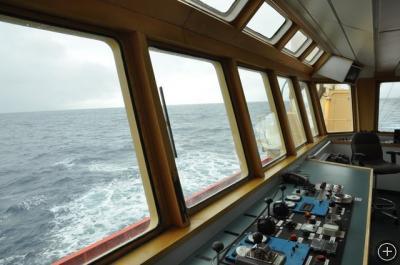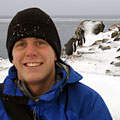A Small Cork in a Big Ocean
ABOARD THE RVIB N. B. PALMER, ON THE SOUTHERN OCEAN– After leaving Punta Arenas, Chile, on January 4th, 2010, and enjoying the calm waters of the Straits of Magellan and the coast of Argentina on our way to the Weddell Sea we have now reached the dreaded Drake Passage. The Drake is a stretch of ocean between the tip of South America and the Antarctic that most ships bound for the Antarctic Peninsula have to cross, and where bad weather and big seas are the norm. Unlike elsewhere in the world the ocean surrounding Antarctica, the Southern Ocean, forms a continuous belt of water around the continent above which all other land masses in the world lay. The Antarctic Circumpolar Current which flows around Antarctica is therefore unhindered by any land mass. As storms form in the Southern Ocean and the winds strengthen, the seas can sometimes become very rough, with very large waves that can be very dangerous to ships that venture there.

View of Antarctica from above the South Pole. Notice that the tip of South America is the only bit of land showing in this view. The body of water surrounding Antarctica you see in this image is the Southern Ocean.
This time around the Drake Passage greeted us with up to 50ft waves and up to 100 knot wind gusts (1 knot equals 1 nautical mile per hour), enough to make this boat feel like a small cork bobbing around in an endless ocean. Walking straight is no option, nor is getting much work done. To make sure everything and everyone is safe scientists, crew, and support staff make sure that everything from computers to chairs and the two helicopters we have on board are tided down to the boat. As the ship rolls, sometimes 16 degrees from side to side, waves break over the side and occasionally drown the deck underneath a wall of water. Our ship the NBP is built to withstand this kind of punishment, and she and us continue our trek towards Antarctica.
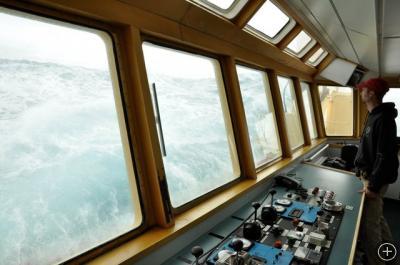
Water spilling over the side of the ship as it rolls in 50ft seas across the Drake Passage. Compare this image to one taken on a calm day (next photo). It really was a wall of water coming down on us.
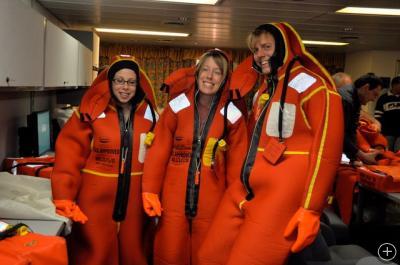
Debra, Laura, and Mattias trying on survival wetsuits. These suits (nicknamed ‘gumby suits’) are meant to keep us warm in the event that the boat capsizes.
Birds, which form an important part of the marine food web partly because of their consumption of fish and other marine life, are on the other hand old hats at dealing with the storm, carefully dodging breaking waves and using the strong winds to glide gracefully in the air. As we move South the species composition of birds sighted from the ship changes. Wandering, Black Browed, and Sooty Albatrosses are common near South America. Soon Cape Petrels start to appear, along with Southern Giant Petrels. Down in the Antarctic we’ll hopefully be seeing Antarctic Terns, Petrels, and Wilson’s Storm Petrels, graceful birds named after their affinity for stormy weather that seem to tip toe on the water’s surface.
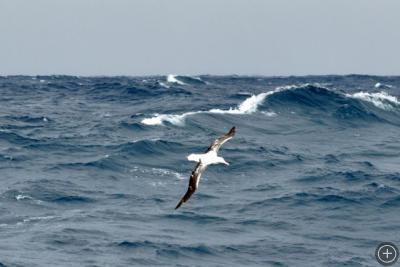
Wandering albatross gliding over the waves. These are the world’s largest birds, with a wingspan of up to 142 inches (363 cm). That’s almost 12 feet! They spend almost their entire life at sea, riding the strong winds of the Southern Ocean.
As we cross we hope conditions will calm down and look forward to reaching the Weddell Sea, the sea East of the Antarctic Peninsula, and eventually the Larsen Ice Shelf System. On our way we will be recovering a ‘whale bone lander’, a metal frame that has been placed at the bottom of the ocean in 600m of water, and on which bones from different species of whales have been placed. Biological oceanographer Craig Smith from the University of Hawaii is interested in the organisms that colonize bones in the deep sea, including Osedax, the bone-eating worm. More on that in the next dispatch. Our group, which focuses on phytoplankton (microscopic algae) in the water column (between the surface and the ocean bottom) will be starting to sample the surface water to see what lives in the uppermost layer of the ocean. Like the birds, the phytoplankton community changes as we move south, and this can have important consequences for the rest of the food chain.

 No comments
No comments 